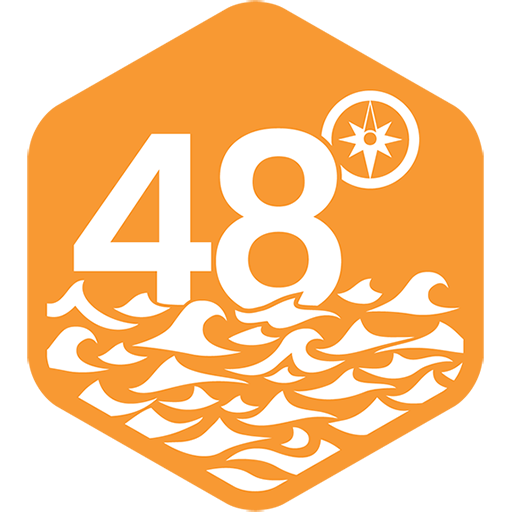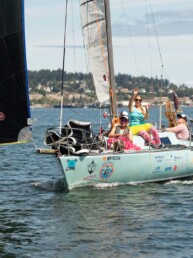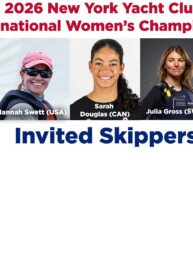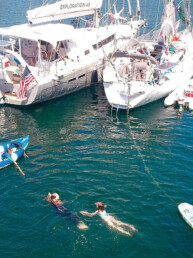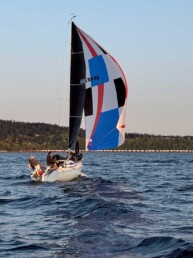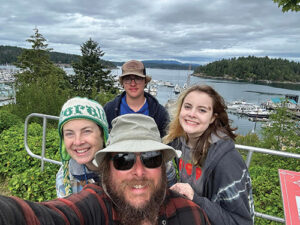
Having raced sailboats on Puget Sound for the past 15 years, I have experienced the beauty of our area year-round and visited many ports before and after races. Yet, the concept of cruising was still very unknown to me. Trips to attend races always had a goal and a schedule. The idea of just setting out with destination and plans largely unknown felt uncomfortable.
When my family suggested last spring that we go cruising together in the San Juan Islands, I was both intrigued and overwhelmed at the prospect of taking my wife and two teenagers sailing for a week on a 27-foot sailboat. But it was also exciting, and this seemed like my chance to dispel the mystery and discomfort that surrounded cruising for me.
About three years ago, I bought our 1977 Catalina 27, Emerald Lady. We’ve raced her hard, enjoying her generous PHRF handicap; and have had some great adventures. Originally designed to be a weekend family racer-cruiser, the Catalina 27 is capable of sleeping five, which we’d done at Blake Island for a single night on a last-minute weekend trip. But let me assure you, this is not a big boat! Besides the sleeping arrangements, I was awash in questions. What was I going to bring for meals? Would my head’s holding tank overflow? How much freshwater should we carry, and where do we store it? How do I set an anchor confidently enough to sleep through the night? And would this be the ultimate test of our family in such close quarters?

Thankfully, in the sailing and cruising community, there are plenty of folks who are there to help. My first question to the cruisers at the Port Orchard Yacht Club was, “Where should I go?” They all told me the same thing, “The best plan is to not have a plan, make it up as you go. Watch the weather and just do whatever you want that day.”
Ok, sure, sounds good in theory, but that’s just not how I’ve ever planned trips before. I began looking at the Waggoner Cruising Guide and learning about this mythical area that I’d never really explored even though it’s only miles from where I grew up in Bellingham. Unknown adventure, right in our own backyard. Experienced folks will tell you that never has to end in this part of the world!
Over the next few months, I spent the time between the races on our schedule cleaning and going through the boat, ensuring that I knew what might break, and trying to maximize space wherever I could find it. We weren’t backpacking, I reminded myself, so we didn’t have to go truly minimalist, but we should be smart about bringing only what we needed.
Knowing my kids would need their electronics, I figured out where to put two small solar panels to keep our phones and battery charged. I also bought some standup paddleboards for them to use for fun and to get to shore. My wife and I planned to rely on the dinghy that came with the boat, though I hadn’t actually ever used it. Hopefully it held air.
Soon the spring racing season was winding down, and my garage was staged with gear to load out. With our final West Sound Sailing Association race on June 22, we set our departure goal two days later on June 24. That would give me and my son, Reed, a day to load the boat for an early departure the following day. The plan was for him and I to spend two days getting the boat to Anacortes where my wife and daughter would meet us.
Excited to be off on our adventure, we were underway at about 8 a.m., motoring north, keeping an eye out for anything that looked like wind. We are sailors after all, and the noise of the outboard gets pretty annoying after an hour or so.
We passed Kingston around noon, and noticed a familiar boat sailing near us in the glassy water. Venturing closer, we recognized it as the J/105 Vamoose. There wasn’t much wind, so we figured either they were just out having fun, or there was an issue. Hailing on the VHF, we learned they were having an engine cooling issue, and the skipper was sailing while rebuilding his water pump. They were headed north too, so we ensured they had our cell numbers, and encouraged them to give us a call if they needed any assistance.
We finally found wind around Point No Point, and were able to shut down the engine and sail for a while. My son took the tiller, and set our course to the south end of Marrowstone Island. This was more like it—sailing, soaking up the sun, and listening to music.
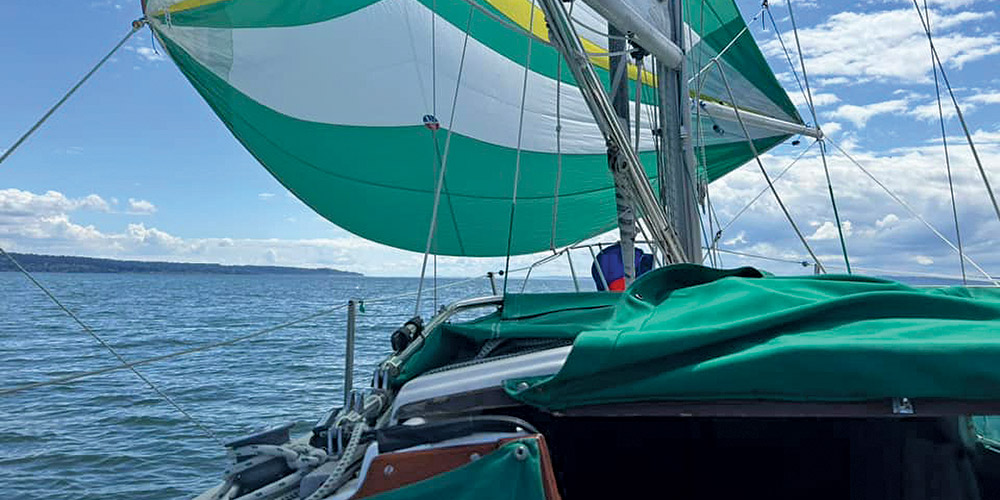
Soon, we wound up in the wind shadow of Marrowstone and fired up the outboard once again to get through the Port Townsend Canal. On the other side though, we met a nice northerly which allowed us to sail yet again, this time all the way up to our destination of Port Townsend as the evening set in. Plenty of daysailers were still out enjoying the pleasant weather as we doused our sails and headed into Boat Haven for the night. Once docked and paid, we realized we could have used the reciprocal slip in the commercial basin; but decided not to move, instead sending directions to that slip to our friends on Vamoose, who likely needed it more than we did given its proximity to West Marine. AIS showed that they were still sailing, so we assumed the problem had not gotten resolved and sent them a text with directions to the slip. They texted back with a hearty thank you, as their engine was still overheating, so they decided to sail up to Port Townsend hoping to arrive around dark. Knowing where to go once there would allow them to use their limited engine time wisely. Helping each other out is what boaters do!
Since we arrived about an hour after the marina office had closed, we couldn’t find the bathroom door code anywhere. After a long day we were eager for a refreshing shower, so I contacted a sailor friend who lives in Port Townsend on the off chance he knew it. He didn’t, but knew someone who would, and got back to me a few minutes later. More boaters helping boaters! With one of our first cruising puzzles solved, we settled in for a relaxing night.
The next morning, I got up and wandered over to our friends on Vamoose, who had gotten in right after sunset. The engine issue was still problematic, but they knew they were in a good spot for troubleshooting, so I wished them well and headed back to wake up my son to get underway. Later that morning they blew out the inlet line, and found that it had been blocked—a 30 second fix that just took many hours to find. Isn’t that how it goes so much of the time? They were soon back on their way to Canada.
We set out at about 9 a.m. with a fresh northerly, hoping to reach Whidbey on the ebb tide before the morning wind died down. We made great time and got close to the Naval Air Station before the breeze ran out against the south running current.
With a little westerly breeze building a bit later, we set the spinnaker, and watched planes flying missions from Whidbey while we took the eastern route around Burrows Island to avoid the current.
Eventually, we fired up the engine again and made our way to Cape Sante Marina for the night. As we were approaching, we saw lots of sailboats we recognized coming into the harbor, and quickly concluded that we had somehow planned this trip to coincide with Anacortes Race Week. What a great surprise to run into racing friends while out cruising.
We tied up and, while I was organizing the boat for the arrival of my wife and daughter the following day, my son ventured off. He found the trails north of the marina and hiked to the top of the bluff. We were starting to appreciate how the pace of cruising allows for that kind of exploration.
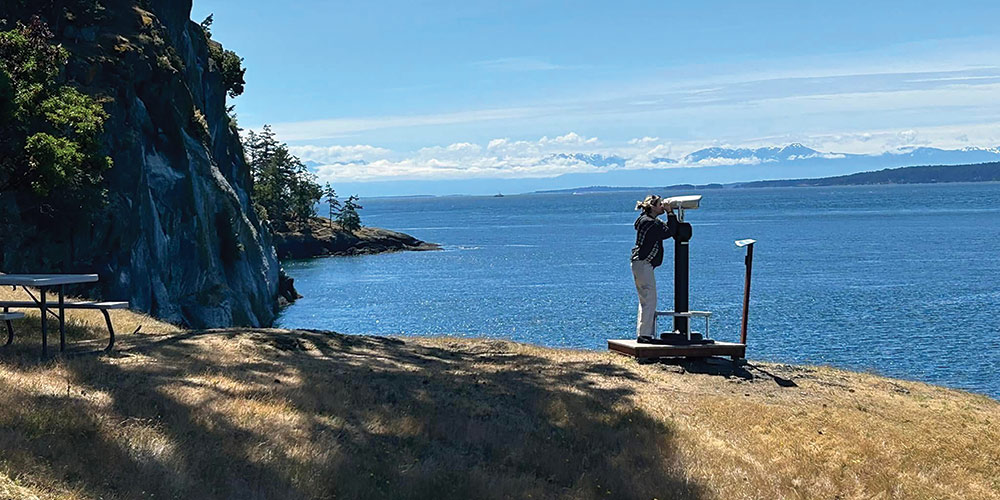
The rest of the family arrived midway through the next morning, and we were underway soon after. We had a strong southerly on the ebb tide and made quick time out of Anacortes, before sailing across a lumpy Rosario Strait. My wife, Cammy, looked a bit concerned with a few waves crashing over the bow, but I assured her this would be short lived as we headed towards Thatcher Pass, the gap between Decatur and Blakely islands. I also remarked that this was just a bit of good racing weather!
As expected, once inside the islands, we had flat seas with light breeze. We decided to head to Friday Harbor first; given the weather, we felt that being in a marina would be a more comfortable night than on anchor. We enjoyed our first passage through the San Juans on our own boat, and found a slip without trouble. After exploring town and grabbing dinner, Cammy and I headed up to the Friday Harbor Yacht Club to say hello and grab a drink. We were disappointed to learn that we were there on a dinner night, and had missed our chance to have dinner at the club; but the hospitality and views were far from disappointing as the sun set.
The following morning, seeing the storm still lingering, we grabbed breakfast in town, and checked out the very cool whale museum before setting out at about noon. With favorable currents and a moderate breeze on our beam, we set sail and headed north.
I wasn’t really sure where we’d end up, but embraced the “make no plans” approach. Steady winds graced us as we took a port tack all the way up the passage to Spieden Island, where the winds finally died. We motored to Stuart Island’s Prevost Harbor and found a mooring ball close to the dock. After securing the mooring, my son’s face quickly grew concerned when he realized that he had no cell signal anymore. I shrugged and suggested he try to find a high spot on shore. The rest of the family wanted to go ashore anyway, so we inflated the dinghy and paddleboards for our inaugural ship-to-shore mission as cruisers.
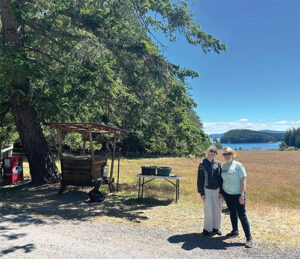
Stuart Island is a remarkably beautiful spot. As Cammy and I walked around, my son set off in search of high ground so he could text with his girlfriend and let her know of his imminent demise due to being off-grid. After an hour of exploring the beach, we headed back to the boat to think about dinner. My daughter paddled around the harbor and enjoyed looking into the pristine waters. After a few hours, Cammy asked, “At what point do we get concerned that Reed isn’t back?” I chuckled, “Dark.”
Not to worry, he soon appeared paddling back to the boat, about three hours after he left. He’d managed to hike out to the Turn Point lighthouse searching for a cell signal, saw orcas and talked to his friends until his phone battery was nearly dead. He said, “This island is pretty cool.” That’s extremely high praise from a teenager! I mentioned that my plan was to go to the lighthouse the next day, so he’d get to see it all again. We made a hearty dinner of tacos and enjoyed a quiet night on the mooring ball. This cruising stuff was turning out to be pretty great.
The next day, we took the inflatables over to the dock (what do you know, the dinghy held air!) and walked up to the lighthouse, with a stop at the trading post where we found some cool T-shirts and cards.The pit toilet at Turn Point lighthouse had a sign warning of unsanitary conditions but, to our surprise, it was the most plush pit toilet we’d ever seen. The lighthouse had a great museum and the caretakers clearly take immense pride in this remote location.
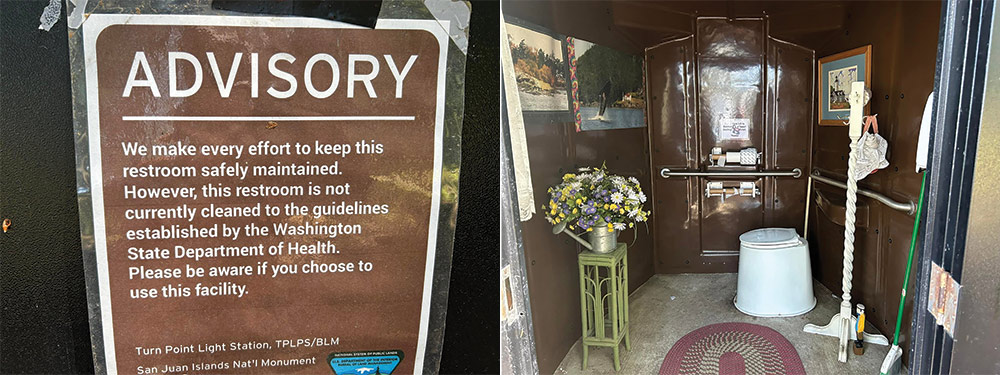
That afternoon, we spent some time on the park dock and had fun meeting and comparing notes with folks from other areas of Puget Sound. We decided that the following day we should hit Deer Harbor for lunch and to empty our holding tank and get ice, then head over to Jones Island.
Setting out the next day, we made a quick motor to Deer Harbor and were glad to accomplish our goals there. We tried to dispose of a small bag of garbage, but decided the $10 fee was too much, so I stashed it in the back of our boat instead.
The weather was falling apart as the afternoon set in, so we decided to shoot for the north shore of Jones for a sheltered night. Jones Island was busy, but I managed to find a good spot to set the anchor. I was thankful for the advice others had given me about what to look for, how to test your hold, and how much scope to set based on the conditions. After an hour of wondering if we were well set, I finally accepted I wasn’t going anywhere and ventured to shore. Cammy and Reed embarked on a hike encircling the island, while I walked over to the other side to get a look and then went back to the boat to organize a few things. One thing about having four people on a 27-foot boat is that everything always needed to get put away, lest there be no room for anyone. And with drizzle setting in, I knew that we’d need what interior space we had. I also put a tarp over the boom, and kicked back listening to music and appreciating my surroundings while my family explored. Though the wind picked up overnight, we were well protected and all slept well. I always figured sleeping on an anchor would be a bit rougher than it actually was.
Cammy and I were up early the next morning and, with our plan to be in Anacortes by late afternoon, we decided to pull anchor while the kids were still asleep. We motored east while sipping fresh coffee. Hunger set in after meandering through the Wasp Islands enjoying the wildlife, so we found a mooring ball at Blind Island to wake up the kids and have breakfast. We contemplated going ashore, but Blind Island seemed so small that we decided to let it go. Instead, we deflated our inflatables and got ready to begin the voyage home.
We found moderate south winds in Rosario Strait, set sail, and decided to take the north route back to Anacortes going north of Cypress and Guemes. We were able to sail the whole way back using the engine just to get into the marina—our longest sail of the whole trip thus far. The reciprocal slip was open, so we made a quick stop to drop off some gear and the ladies, filled up at the fuel dock, and Reed and I decided to use the evening light to begin the trip home via LaConner. After a two-hour motor through the Swinomish Slough, with most powerboats respectfully slowing down to minimize their wake next to us, we arrived at the reciprocal dock between two large powerboats for the night.
We found a great dinner and, as we meandered through town, our only regret was that many of the businesses we would have liked to see were closed for the night. I told Reed I’d be up early the next day and planned to shove off while he was still asleep. Back in reliable cell phone range, he spent the evening catching up with friends on a bench in the park.
The early light peeked through my hatch as the sun rose, and I made quick time getting us off the dock and underway. I was a bit concerned at the fact that I was transiting the Swinomish Channel and Skagit Bay on a minus tide. Folks had told me it was dredged, and our boat only draws 4 feet, but it still felt a bit harrowing as I looked out across the mud flats in the morning sun. I set the depth alarm at 5 feet, and hoped for the best. As many others had reported, I found the area of the channel that was sluffing near the end, but managed to keep us out of the mud.
I continued south and, with Oak Harbor in sight, found a moderate westerly wind coming in off the Strait of Juan de Fuca, just like the weather models predicted. The waves slamming the bow wound up being enough to rouse my son from his slumber, which was handy because I was ready to sail anyway. Passing the north end of Camano Island, we set sail, and headed south on a starboard tack. After an hour, the wind shifted behind us, so we were able to set our spinnaker and enjoy the run south while rocking out to music. We finally reached the end of the wind around Edmonds and fired up the outboard again. We figured that was the end of our sailing, but fortunately we found wind one more time at Jefferson Head, and were able to sail to Agate Pass.
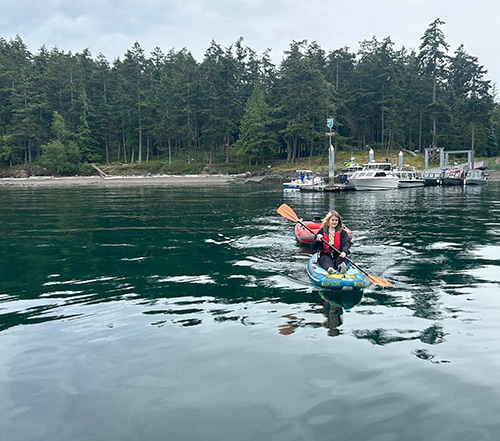
At Agate Pass, we noticed a boat full of people going around in circles intermittently. As we approached, we saw the captain give a two armed wave. We immediately dropped our sails and fired up the engine to assist. Once alongside them, we learned that they had lost steering, and vessel assist was on the way, but that it’d been an hour and he was doing what he could to keep it off the shore. We pulled them a bit farther away from the shore, and offered to take some of the folks back to their house near Manzanita since we were headed that way. After a brief discussion and a call back to vessel assist for an ETA, they appreciatively declined as vessel assist would be there shortly. Since we had offered assistance to a fellow boat on our first day, it seemed like we’d come full circle to be in that position again on our final day. Just doing what boaters do! Ensuring everyone was ok, we got underway again, and pulled into our homeport at the Port Orchard Yacht Club right as the evening colors began to show and the shipyard played taps.
There it was—eight days underway, a family of four with two teenagers, 27 feet of our 47-year-old Emerald Lady. We successfully took her cruising and survived to tell about it.
We learned a lot about cruising, and about the different kinds of fun and rewards it offers than the sailing I’d been doing for the past 15 years. We’re already planning to return, and look forward to spending lots more time cruising the Salish Sea with no plan.
Gerry Austin and his family are West Sound racers and budding cruisers aboard their Catalina 27, Emerald Lady.
